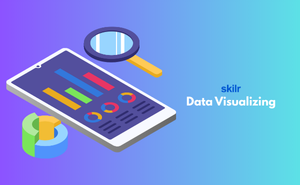👇 CELEBRATE CLOUD SECURITY DAY 👇
00
HOURS
00
MINUTES
00
SECONDS

Data visualization uses visual representations to show patterns and trends in data and provide readers with easy access to key insights. Data visualization tools offer an easy approach to observing and analyzing trends, outliers, and patterns in data by utilizing visual components like charts, graphs, and maps.
Business users may utilize data visualization to understand their massive data sets. They gain by being able to spot fresh patterns and data mistakes. The users can focus on locations that show red flags or progress by making sense of these patterns. This procedure then propels the company forward.
To succeed in the exam, you should have the following technical and analytical skills:
Industry-endorsed certificates to strengthen your career profile.
Start learning immediately with digital materials, no delays.
Practice until you’re fully confident, at no additional charge.
Study anytime, anywhere, on laptop, tablet, or smartphone.
Courses and practice exams developed by qualified professionals.
Support available round the clock whenever you need help.
Easy-to-follow content with practice exams and assessments.
Join a global community of professionals advancing their skills.
Yes, most providers require a waiting period of 14 to 30 days before a candidate can retake the exam. There may also be a limit on the number of retakes allowed annually.
Yes, successful candidates typically receive a digital certificate that can be downloaded, printed, or shared online, verifying their expertise in data visualization.
Yes, the majority of recognized certification bodies offer a remote proctored version of the exam, allowing candidates to take it from their home or office under monitored conditions.
Most certifying bodies require a minimum score of 70% to 75% to pass the exam, though this may vary depending on the exam provider.
Depending on the exam provider, candidates may be tested on specific tools such as Tableau, Power BI, or open-source libraries like Matplotlib and Seaborn. Tool-specific exams may require hands-on demonstrations.
The exam duration is usually between 90 to 120 minutes and may be conducted online or in-person. It includes a mix of theoretical and practical application questions.
The exam covers data preparation, visualization design principles, usage of visualization tools, interactive dashboard creation, data storytelling, ethical practices in visualization, and real-world case applications.
The purpose of the exam is to validate a candidate’s ability to transform complex data sets into clear, effective, and insightful visual representations using industry-standard tools and best practices.
The exam typically includes multiple-choice questions, scenario-based case studies, and interactive questions where candidates may be asked to interpret or select appropriate visual formats for given datasets.
There are no strict prerequisites, but candidates are expected to have foundational knowledge in data analysis and experience with at least one data visualization tool such as Tableau, Power BI, or Google Data Studio.